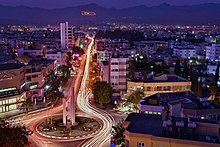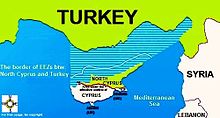| Revision as of 16:59, 24 January 2021 editGreenC bot (talk | contribs)Bots2,548,707 edits Move 1 url. Wayback Medic 2.5← Previous edit | Revision as of 10:07, 10 February 2021 edit undoPavlosmeta (talk | contribs)70 editsNo edit summaryTag: RevertedNext edit → | ||
| Line 34: | Line 34: | ||
| |aid = | |aid = | ||
| }} | }} | ||
| The '''economy of Northern Cyprus''' is dominated by the services sector (69% of GDP in 2007), which includes the public sector, trade, tourism and education. Industry (light manufacturing) contributes 22% of GDP and agriculture 9%.<ref name="autogenerated1">: scroll down to section entitled '''Economy of the area administered by Turkish Cypriots'''</ref> ]'s economy operates on a free-market basis, with a significant portion of administration costs funded by ]. Northern Cyprus uses the ] as its currency, which links its economic situation to the ]. | The '''economy of Northern Cyprus''' (Turkish occupied part of Cyprus Republic) is dominated by the services sector (69% of GDP in 2007), which includes the public sector, trade, tourism and education. Industry (light manufacturing) contributes 22% of GDP and agriculture 9%.<ref name="autogenerated1">: scroll down to section entitled '''Economy of the area administered by Turkish Cypriots'''</ref> ]'s economy operates on a free-market basis, with a significant portion of administration costs funded by ]. Northern Cyprus uses the ] as its currency, which links its economic situation to the ]. | ||
| As of 2014, the GDP per capita of Northern Cyprus was $15,109, and the GDP was $4.039 billion. The economy grew by 4.9% in 2014 and 2.8% in 2013, meaning that Northern Cyprus is growing faster than the Republic of Cyprus.<ref name=trec1>{{cite web|title=KKTC|url=http://www.ekonomi.gov.tr/portal/faces/home/disIliskiler/ulkeler/ulke-detay/KKTC;jsessionid=GS7VrcKEc1o6yd5UlOZhSIoh1K3ejD71nzGDyj5CcmUWENtuLSlV!-1231570490?_afrLoop=322898295967035&_afrWindowMode=0&_afrWindowId=null#!%40%40%3F_afrWindowId%3Dnull%26_afrLoop%3D322898295967035%26_afrWindowMode%3D0%26_adf.ctrl-state%3Dpzppiyptv_4|publisher=Turkish Ministry of Economy|access-date=28 July 2015|language=tr}}</ref><ref>{{cite web|title=Political deal may boost Cypriot economy|url=http://www.dailysabah.com/economy/2014/07/22/political-deal-may-boost-cypriot-economy|publisher=Daily Sabah|access-date=28 July 2015}}</ref> Northern Cyprus has seen economic growth and declining unemployment throughout the 2010s; the unemployment rate in 2015 was at 7.4%,<ref name="kibrisis">{{cite web|title=KKTC'de işsizlik %7.4|url=http://www.kibrisgazetesi.com/?p=802591|publisher=Kıbrıs|access-date=6 June 2016}}</ref> down from 8.3% in 2014.<ref name=kibissiz>{{cite web|title=En yüksek işsizlik oranı Güzelyurt’ta|url=http://www.kibrispostasi.com/index.php/cat/35/news/162469/PageName/KIBRIS_HABERLERI|publisher=Kıbrıs Postası|access-date=29 July 2015|language=tr}}</ref> The inflation rate in June 2015 was at 3.18%.<ref name=dpoenf>{{cite web|title=2008=100 TEMEL YILI TÜKETİCİ FİYATLARI ENDEKSİNİN 2015 HAZİRAN AYI SONUÇLARI|url=http://www.devplan.org/T%C3%BCfe/Endeks/Tur/2015/Tufe-2015-6.pdf|publisher=State Planning Organization|access-date=29 July 2015}}</ref><ref name=kibissiz/><ref name=socin2/> | As of 2014, the GDP per capita of Northern Cyprus was $15,109, and the GDP was $4.039 billion. The economy grew by 4.9% in 2014 and 2.8% in 2013, meaning that Northern Cyprus is growing faster than the Republic of Cyprus.<ref name=trec1>{{cite web|title=KKTC|url=http://www.ekonomi.gov.tr/portal/faces/home/disIliskiler/ulkeler/ulke-detay/KKTC;jsessionid=GS7VrcKEc1o6yd5UlOZhSIoh1K3ejD71nzGDyj5CcmUWENtuLSlV!-1231570490?_afrLoop=322898295967035&_afrWindowMode=0&_afrWindowId=null#!%40%40%3F_afrWindowId%3Dnull%26_afrLoop%3D322898295967035%26_afrWindowMode%3D0%26_adf.ctrl-state%3Dpzppiyptv_4|publisher=Turkish Ministry of Economy|access-date=28 July 2015|language=tr}}</ref><ref>{{cite web|title=Political deal may boost Cypriot economy|url=http://www.dailysabah.com/economy/2014/07/22/political-deal-may-boost-cypriot-economy|publisher=Daily Sabah|access-date=28 July 2015}}</ref> Northern Cyprus has seen economic growth and declining unemployment throughout the 2010s; the unemployment rate in 2015 was at 7.4%,<ref name="kibrisis">{{cite web|title=KKTC'de işsizlik %7.4|url=http://www.kibrisgazetesi.com/?p=802591|publisher=Kıbrıs|access-date=6 June 2016}}</ref> down from 8.3% in 2014.<ref name=kibissiz>{{cite web|title=En yüksek işsizlik oranı Güzelyurt’ta|url=http://www.kibrispostasi.com/index.php/cat/35/news/162469/PageName/KIBRIS_HABERLERI|publisher=Kıbrıs Postası|access-date=29 July 2015|language=tr}}</ref> The inflation rate in June 2015 was at 3.18%.<ref name=dpoenf>{{cite web|title=2008=100 TEMEL YILI TÜKETİCİ FİYATLARI ENDEKSİNİN 2015 HAZİRAN AYI SONUÇLARI|url=http://www.devplan.org/T%C3%BCfe/Endeks/Tur/2015/Tufe-2015-6.pdf|publisher=State Planning Organization|access-date=29 July 2015}}</ref><ref name=kibissiz/><ref name=socin2/> | ||
Revision as of 10:07, 10 February 2021
 North Nicosia is the economic center of Northern Cyprus North Nicosia is the economic center of Northern Cyprus | |
| Currency | Turkish lira (₺) (TRY) |
|---|---|
| Fiscal year | Calendar year |
| Trade organisations | ECO (observer) |
| Statistics | |
| GDP | |
| GDP rank | 157th (nominal, if ranked according to the World Bank) |
| GDP growth | |
| GDP per capita | $14,942 (Nominal, 2018) |
| Inflation (CPI) | |
| Unemployment | |
| Main industries | tourism, education, agriculture |
| External | |
| Exports | |
| Export goods | Dairy products, raw and processed citrus, rakı, scrap, chicken, potatoes |
| Main export partners | |
| Imports | |
| Main import partners | |
| All values, unless otherwise stated, are in US dollars. | |
The economy of Northern Cyprus (Turkish occupied part of Cyprus Republic) is dominated by the services sector (69% of GDP in 2007), which includes the public sector, trade, tourism and education. Industry (light manufacturing) contributes 22% of GDP and agriculture 9%. Northern Cyprus's economy operates on a free-market basis, with a significant portion of administration costs funded by Turkey. Northern Cyprus uses the Turkish lira as its currency, which links its economic situation to the economy of Turkey.
As of 2014, the GDP per capita of Northern Cyprus was $15,109, and the GDP was $4.039 billion. The economy grew by 4.9% in 2014 and 2.8% in 2013, meaning that Northern Cyprus is growing faster than the Republic of Cyprus. Northern Cyprus has seen economic growth and declining unemployment throughout the 2010s; the unemployment rate in 2015 was at 7.4%, down from 8.3% in 2014. The inflation rate in June 2015 was at 3.18%.
Embargo, debt and Turkey's role
Main article: Embargo against Northern Cyprus
Because of its international status and the embargo on its ports, the TRNC is heavily dependent on Turkish military and economic support. All TRNC exports and imports have to take place via Turkey, unless they are produced locally, from materials sourced in the area (or imported via one of the island's recognised ports) when they may be exported via one of the legal ports.
The continuing Cyprus problem adversely affects the economic development of the TRNC. The Republic of Cyprus, as the internationally recognised authority, has declared airports and ports in the area not under its effective control, closed. All UN and EU member countries respect the closure of those ports and airports according to the declaration of the Republic of Cyprus. The Turkish community argues that the Republic of Cyprus has used its international standing to handicap economic relations between TRNC and the rest of the world.
There are three-year-long programs of financial and economical cooperation between Turkey and Northern Cyprus. In 2013, Turkey transferred 430 million Turkish liras to the Turkish Cypriot budget, comprising 5.7% of the GNP, and one-seventh of the state budget. The aid from Turkey had decreased from 7.1% of the budget in 2004. In addition, 2013 saw a budget deficit amounting to 7.2% of the GNP, and a credit amounting to 6.6% of the GNP was obtained from Turkey. Between 2004 and 2013, Northern Cyprus constantly had a budget deficit, peaking at 14.0% of the GNP in 2009. This prompted constant borrowing from Turkey, reaching a maximum of 12.2% of the GNP in 2009. In December 2014, Northern Cyprus had a total debt of 23 million Turkish liras, 7.5 million liras being external debt to Turkey. This amounted to 1.5 times the GDP.
Economic growth

Despite the constraints imposed by the lack of international recognition, the TRNC economy turned in an impressive performance. The nominal GDP growth rates of the TRNC economy in 2001-2005 were 5.4%, 6.9%, 11.4%, 15.4% and 10.6%, respectively. The real GDP growth rate in 2007 is estimated at 2%. This growth has been buoyed by the relative stability of the Turkish Lira and a boom in the education and construction sectors.
The growth was further buoyed by the arrival of North European Home Buyers, investing in holiday villas. Over 10,000 British people, including expatriates purchased holiday villas there to live in permanently, or to visit during the summer months. These settlers generated over $1 Billion between 2003 and 2007.
Between 2002 and 2007, Gross National Product per capita more than tripled (in current US dollars):
- US$4,409 (2002)
- US$5,949 (2003)
- US$8,095 (2004)
- US$10,567 (2005)
- US$11,837 (2006)
- US$14,047 (2007, provisional)
Studies by the World Bank show that the per capita GDP in TRNC grew to 76% of the per capita GDP in the Republic of Cyprus in PPP-adjusted terms in 2004 (US$22,300 for the Republic of Cyprus and US$16,900 for the TRNC). Official estimates for the GDP per capita in current US dollars are US$8,095 in 2004 and US$11,837 in 2006.
Development



Although the TRNC economy has developed in recent years, it is still dependent on monetary transfers from the Turkish government. Under a July 2006 agreement, Ankara is to provide Northern Cyprus with an economic aid in the amount of $1.3 billion over three years (2006–2008). This is a continuation of ongoing policy under which Turkish government allocates around $400 million annually from its budget to help raise the living standards of the Turkish Cypriots.
Tourism
Main article: Tourism in Northern CyprusThe tourism sector of Northern Cyprus has seen high levels of constant growth. 1.23 million tourists visited Northern Cyprus in 2013, 920,000 of these being from Turkey. The number of tourists had doubled since 2006, which saw 570,000 tourists. The revenue from tourism was at $616 million, up from $390 million in 2009 and $288 million in 2004.
The number of tourist beds increased to 17,000 in 2011.
Banking
The Banking sector grew 114% from 2006 to 2011. TRNC Development Bank is a member of the Association of Development Financing Institutions in Asia and the Pacific (ADFIAP).
Exports and imports
WTO statistically counts products from Northern Cyprus as products from Turkey.
In 2014, the exports of Northern Cyprus were at $130 million, with an increase of 11.9% from 2013, and the imports were at $1.51 billion, with an increase of 3.6% from 2013. The main trading partner is Turkey, as of 2014, 64.7% of Turkish Cypriot imports are from and 58.5% of Turkish Cypriot exports are to Turkey. Middle Eastern countries are the destination of 30.3% of Turkish Cypriot exports and their share in the exports of Northern Cyprus has greatly increased, being at only 17.8% at 2006. The share of exports to the European Union has greatly decreased from 15.0% in 2006 to 6.2% in 2014, while imports from the European Union were 15.5% of all imports.
The agricultural sector is the source of the vast majority of exported goods. In 2013, 32.4% of exported products were raw agricultural products and 50.8% were processed agricultural products. 8.7% of the exports was minerals, 3.0% clothing and 5.1% other industrial products. Raw citrus by itself constituted 19.1% of all exports. The most important exported products, in order of the revenue they produce, are dairy products, citrus, rakı, scrap, citrus concentrate, chicken and potatoes.
Below is a table showing the distribution of exports of Northern Cyprus by goods:
| Distribution of TRNC exports by goods (US dollar) | |||||||||||
|---|---|---|---|---|---|---|---|---|---|---|---|
| 2007 | 2008 | 2009 | 2010 | ||||||||
| Citrus | 22,692,324 | 20,502,086 | 13,910,934 | 27,166,238 | |||||||
| Dairy products | 20,650,394 | 21,628,852 | 20,074,239 | 25,836,381 | |||||||
| Rakı | 4,482,406 | 6,653,821 | 8,413,631 | 7,669,936 | |||||||
| Scrap | 8,141,653 | 7,283,664 | 4,237,831 | 6,477,316 | |||||||
| Ready-made clothing | 6,790,020 | 3,727,264 | 2,326,900 | 4,022,957 | |||||||
| Citrus concentrate | 3,192,255 | 662,939 | 1,746,922 | 3,007,110 | |||||||
| Gypsum | 1,894,924 | 3,927,030 | 2,490,925 | 1,889,140 | |||||||
| Pharmaceuticals | 955,693 | 1,009,966 | 649,465 | 1,573,599 | |||||||
| Leather products | 1,269,816 | 908,411 | 594,751 | 461,562 | |||||||
| Other products | 8,975,744 | 6,354,090 | 9,002,188 | 12,579,609 | |||||||
| Exports to the Republic of Cyprus | 4,639,584 | 11,006,015 | 7,615,978 | 5,746,061 | |||||||
| Total | 83,684,813 | 83,664,138 | 71,063,766 | 96,419,909 | |||||||
References
- ^ "KKTC" (PDF). www.kei.gov.tr. 2018. Retrieved 2020-05-26.
- ^ "KKTC Merkez Bankası 2014 IV. Çeyrek Raporu" (PDF) (in Turkish). TRNC Central Bank. pp. 9–10. Retrieved 29 July 2015.
- "Stats" (PDF). ticaret.gov.ct.tr. Retrieved 2020-05-26.
- "Ocak" (PDF). ticaret.gov.ct.tr. 2018. Retrieved 2020-05-26.
- ^ CIA - The World Factbook - Cyprus: scroll down to section entitled Economy of the area administered by Turkish Cypriots
- "KKTC" (in Turkish). Turkish Ministry of Economy. Retrieved 28 July 2015.
- "Political deal may boost Cypriot economy". Daily Sabah. Retrieved 28 July 2015.
- "KKTC'de işsizlik %7.4". Kıbrıs. Retrieved 6 June 2016.
- ^ "En yüksek işsizlik oranı Güzelyurt'ta" (in Turkish). Kıbrıs Postası. Retrieved 29 July 2015.
- "2008=100 TEMEL YILI TÜKETİCİ FİYATLARI ENDEKSİNİN 2015 HAZİRAN AYI SONUÇLARI" (PDF). State Planning Organization. Retrieved 29 July 2015.
- ^ Economic and Social Indicators 2013. TRNC State Planning Organization. pp. 2–3.
- "Universities: Little accord on the island - Higher, Education - The Independent". Archived from the original on 2008-01-11. Retrieved 2008-12-29.
- "Foreign aid fungibility and military spending: The case of North Cyprus". Defence and Peace Economics. 25: 499–508. doi:10.1080/10242694.2013.763628.
- "The Impact of Military Spending on Economic Growth: The Case of North Cyprus". Defence and Peace Economics. 22: 555–562. doi:10.1080/10242694.2011.562370.
- "Türkiye'den KKTC'ye 2015'in ilk üç ayında ne kadar yardım gitti?" (in Turkish). T24. Retrieved 28 July 2015.
- Economic and Social Indicators 2013. TRNC State Planning Organization. pp. 21–23.
- "Maliye Bakanı Mungan bütçeyi sundu" (in Turkish). Yeni Düzen. 8 December 2014. Retrieved 28 July 2015.
- ^ Cyprus after Accession: Thinking Outside the Box – Background Documents, University of Oxford, European Studies Centre, Workshop on Cyprus 10–11 March 2006
- ^ General information about North Cyprus: Economy, web site of Unistar Investments Ltd., Bellapais, North Cyprus
- ^ Economic and Social Indicators 1977-2007, TRNC State Planning Organization, February 2008
- Turkey, N. Cyprus sign economic development deal Archived 2009-01-25 at the Wayback Machine, Hurriyet Turkish Daily News, 4 May 2007.
- Feridun, Mete (2014) Foreign aid fungibility and military spending: the case of North Cyprus. Defence and Peace Economics, 25 (5). pp. 499-508. ISSN 1024-2694 (Print), 1476-8267 (Online) (doi:10.1080/10242694.2013.763628)
- Feridun, Mete, Sawhney, Bansi and Shahbaz, Muhammad (2011) The impact of military spending on economic growth: the case of North Cyprus. Defence and Peace Economics, 22 (5). pp. 555-562. ISSN 1024-2694 (print), 1476-8267 (online) (doi:10.1080/10242694.2011.562370)
- ^ Zaman Newspaper 01 Sept 2011 Archived November 7, 2013, at the Wayback Machine
- ADFIAP Northern Cyprus DB is a member
- "Moving Borders: Russia's Creative Entry into the World Trade Organization (WTO)". Daniel Warner, Alternatives: Global, Local, Political, 2014, Vol. 39(2) 90-107, page105. Retrieved 25 March 2020.
- Economic and Social Indicators 2013. TRNC State Planning Organization. p. 27.
- "Dış Ticaret" (in Turkish). Turkish Ministry of Economy. Retrieved 29 July 2015.
- TRNC Ministry of Economy and Energy, Department of Trade. Dış Ticaret İthalat ve İhracat İstatistikleri 2010, p. VI.
| Northern Cyprus articles | |||||||||||||
|---|---|---|---|---|---|---|---|---|---|---|---|---|---|
| History | |||||||||||||
| Geography | |||||||||||||
| Foreign relations | |||||||||||||
| Politics |
| ||||||||||||
| Economy | |||||||||||||
| Society |
| ||||||||||||
| Economy of Europe | |
|---|---|
| Sovereign states |
|
| States with limited recognition | |
| Dependencies and other entities | |
| Other entities | |